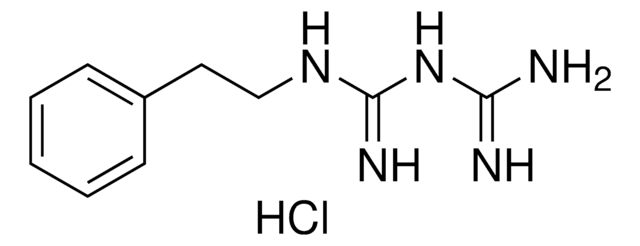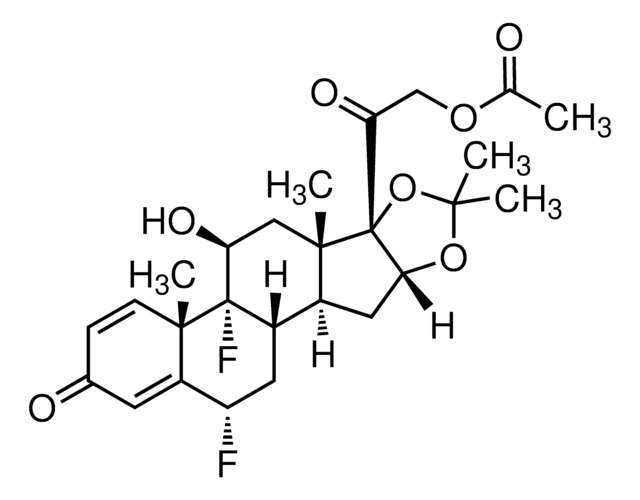P7045
Phenformin hydrochloride
analytical standard
Synonym(s):
N-(2-Phenylethyl)imidodicarbonimidic diamide monohydrochloride, Phenethylbiguanide
Sign Into View Organizational & Contract Pricing
All Photos(2)
About This Item
Empirical Formula (Hill Notation):
C10H15N5 · HCl
CAS Number:
Molecular Weight:
241.72
EC Number:
MDL number:
UNSPSC Code:
41116107
PubChem Substance ID:
NACRES:
NA.24
Recommended Products
grade
analytical standard
Quality Level
technique(s)
HPLC: suitable
gas chromatography (GC): suitable
application(s)
forensics and toxicology
pharmaceutical (small molecule)
format
neat
SMILES string
Cl.NC(=N)NC(=N)NCCc1ccccc1
InChI
1S/C10H15N5.ClH/c11-9(12)15-10(13)14-7-6-8-4-2-1-3-5-8;/h1-5H,6-7H2,(H6,11,12,13,14,15);1H
InChI key
YSUCWSWKRIOILX-UHFFFAOYSA-N
Looking for similar products? Visit Product Comparison Guide
General description
Phenformin hydrochloride is a biguanide derivative that shows anti-diabetic activity.
Application
Phenformin hydrochloride has been used as a test compound to study the antineoplastic activity it can exhibit in suppressing the growth of ovarian cancer cells and also human hepatocellular carcinoma cells.
Refer to the product′s Certificate of Analysis for more information on a suitable instrument technique. Contact Technical Service for further support.
Choose from one of the most recent versions:
Already Own This Product?
Find documentation for the products that you have recently purchased in the Document Library.
Customers Also Viewed
Relevance of the OCT1 transporter to the antineoplastic effect of biguanides
Segal D E, et al.
Biochemical and Biophysical Research Communications, 414(4), 694-699 (2011)
Valentina R Garbarino et al.
Pharmacological research, 140, 21-32 (2018-11-14)
Poorly managed gestational diabetes can lead to severe complications for mother and child including fetal overgrowth, neonatal hypoglycemia and increased autism risk. Use of metformin to control it is relatively new and promising. Yet safety concerns regarding gestational metformin use
Energy metabolism determines the sensitivity of human hepatocellular carcinoma cells to mitochondrial inhibitors and biguanide drugs
Hsu C-C, et al.
Oncology Reports, 34(3), 1620-1628 (2015)
Kevin R W Ngoei et al.
Cell chemical biology, 25(6), 728-737 (2018-04-17)
The AMP-activated protein kinase (AMPK) αβγ heterotrimer regulates cellular energy homeostasis with tissue-specific isoform distribution. Small-molecule activation of skeletal muscle α2β2 AMPK complexes may prove a valuable treatment strategy for type 2 diabetes and insulin resistance. Herein, we report the
Mozhgan Sedigh-Ardekani et al.
Regulatory toxicology and pharmacology : RTP, 70(2), 514-518 (2014-09-10)
Lactic acidosis occurs in a number of clinical conditions, e.g. in surgeries, orthotopic liver transplant, and anesthetic agent administration, which has deleterious effects on the patient's survival. The most rational therapy for these patients, the sodium bicarbonate administration, cannot prevent
Our team of scientists has experience in all areas of research including Life Science, Material Science, Chemical Synthesis, Chromatography, Analytical and many others.
Contact Technical Service












